 If you’re not polarizing, you’re not monetizing.
If you’re not polarizing, you’re not monetizing.
If you’re making people react, you’re not making a difference.
If everybody loves what you’re doing, you’re doing something wrong.
THAT’S YOUR CHALLENGE: Create something worth being criticized.
Otherwise you’re boring.
Just another slice of average cut from the mediocre multitude.
Otherwise you’re ignored.
Just another non-entity in the infinite grey mass of blah blah blah.
Otherwise you’re forgotten.
Just another flash-in-the-pan, all-shtick-no-substance, one-trick-pony.
AND THE TRUTH IS: Criticism isn’t something you draw – it’s something you earn.
If you want to create something worth being criticized, consider these ideas:
1. Change your reactions to criticism. In The War of Art, Steven Pressfield suggests that we recognize criticism (especially the envy-driven variety) for what it really is: Supreme compliment.
“The critic hates most what he wishes he would have done himself he had the guts.”
Lesson learned: Next time someone attacks you, smile. Even if you do so internally. Know that you’ve done your job and that it’s probably got nothing to do with you. In fact, consider keeping Criticism Log. Document daily victories of being hated – even in minor moments – as reminders that you haven’t lost your edge. What’s your definition of (and relationship with) criticism?
2. Assess the risk. There is an inverse relationship between your willingness to risk and the likelihood of criticism. For example, one of the questions I ask myself every morning as I sit down to work is, “What do I risk is presenting this material?”
If the answer is “not much” or “nothing,” I either rework it – or don’t publish it at all. It’s simply not daring enough. Too much ink, not enough blood. And whether you’re a writer or not, the challenge is the same: Create a filter for your own work that reinforces the importance of risk. You might ask, “Who will this idea piss off?” or “How much hatemail will this garner?”
Otherwise you’re just wasting your time. Otherwise you’re just winking in the dark. How do you assess the risk of what you release to the world?
3. Disturb people. The word “disturb” comes from the Latin emotere – the same derivative as the word “emotion.” That’s all you’re doing when you’re being a disturbance: Evoking emotion. Interrupting the quiet. Unsettling the peace. Upsetting the mental landscape. Could be positive or negative or neutral. Doesn’t matter.
The point is: You can’t go down in history if you’re not willing to shake things up in the present. Therefore: Learn to be constructively challenging – but without being ignorantly defiant. Learn to be delightfully disturbing – but without being painfully annoying.
After all, grinding the gears just because you love the sound doesn’t help anyone. And doing something just for the sake of being criticized isn’t worth being criticized for. Are your monkey wrenches well intentioned?
4. Wage an ongoing war against mediocrity. People who maintain a constant posture of challenging the process don’t just get noticed – they get nailed to crosses. Which, if you have thick enough skin – and perhaps some snacks to hold you over until the cavalry comes (no pun intended) – isn’t as bad as it sounds.
Take Bill Maher, for example. In the aftermath of 9/11, he refuted president Bush’s message that the terrorists were cowards: “We have been the real cowards, lobbing cruise missiles from 2,000 miles away,” explained Maher on Political Incorrect, “And staying in the airplane when it hits the building, say what you want about it, isn’t cowardly.”
Not surprisingly, Maher’s comments became a major controversy. Advertisers withdrew their support. Affiliates stopped airing the show temporarily. Even White House press secretary Ari Fleischer denounced Maher, according to the show’s Wikipedia page.
Sure enough, Politically Incorrect was cancelled six months later. Shortly thereafter, Maher moved to HBO to start shooting Real Time, which has recently been resigned for its ninth and tenth seasons. According to Nancy Geller, senior vice president, HBO Entertainment, “Bill Maher is one of the most sought-after opinion makers on TV, and I’m delighted that this fearless and provocative observer will return to HBO next year.”
Oh, and did I mentioned that since getting kicked off the air in 2002, Maher produced, wrote and directed the seventh most successful documentary of all time? Yep. Lesson learned: Violently refuse to become a follower of the common ways of the mediocre masses. Are you letting the world bring your average down, or are you dedicated to bringing its average up?
5. Negativity sucks – but silence sucks money out of your bank account. Oscar Wilde as right: “The only thing worse than being talked about – is not being talked about.” For example, I’d rather have my readers say that my books are drivel-filled hamster terds – than say nothing at all. And I’d rather my audience members tell me I was the worst speaker on the planet than sit there for an hour sexting their boyfriends.
Disagreement and doubt is a form of engagement. It means people heard you, and that’s what matters. Like Counting Crows’ Adam Duritz once said in a Rolling Stone Interview, “Happiness would be nice. Sadness would suck. But insignificance is the worth thing of all.” Next time your work gets beamed, consider it a victory. Better to be impugned than to be ignored. Are you earning criticism or hearing crickets?
6. Honesty scares people. Creating art is a simple process: Slice open a vein and bleed your truth all over the page. Note well: I used the words “vein, blood and truth.” That’s the difference-maker: Criticism is earned by people who are willing to dance along, happily cross and stretch miles beyond the line.
My suggestion: Go there. “Take a chance – tell the truth,” as George Carlin reminded us. Take your readers, audience members and viewers somewhere they didn’t want to go – or never thought they’d go – but then make them so grateful they’re there that they never want to leave. How are you branding your honesty?
REMEMBER: Anything worth doing is worth being attacked for.
Ultimately, creating something worth being criticized is a risky, demanding and unglamorous process.
But that’s what difference makers do.
Sure as hell beats being ignored.
LET ME ASK YA THIS…
When was the last time you received hate mail?
LET ME SUGGEST THIS…
For the list called, “49 Ways to become an Idea Powerhouse,” send an email to me, and I’ll send you the list for free!
* * * *
Scott Ginsberg
That Guy with the Nametag
Author, Speaker, Coach, Entrepreneur
[email protected]
 Never the same speech twice.
Never the same speech twice.
Always about approachability.
Watch The Nametag Guy in action here!

 Execution isn’t a hobby.
Execution isn’t a hobby.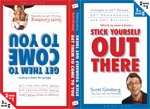 The world’s FIRST two-in-one, flip-flop book!
The world’s FIRST two-in-one, flip-flop book! “Nothing should be called good that fails to enlarge our humanity.”
“Nothing should be called good that fails to enlarge our humanity.”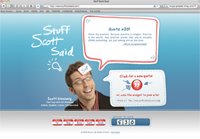 Who’s quoting YOU?
Who’s quoting YOU? Finished is the new perfect.
Finished is the new perfect.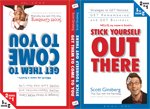 The world’s FIRST two-in-one, flip-flop book!
The world’s FIRST two-in-one, flip-flop book! Stick-to-itiveness can be learned.
Stick-to-itiveness can be learned.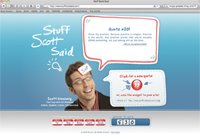 Who’s quoting YOU?
Who’s quoting YOU? Sometimes the best choice is the decision to stop choosing.
Sometimes the best choice is the decision to stop choosing. “When will you have done enough to be happy with who you are?”
“When will you have done enough to be happy with who you are?”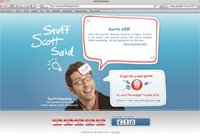 Who’s quoting YOU?
Who’s quoting YOU? Determination alone fails.
Determination alone fails. 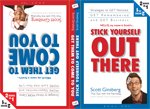 The world’s FIRST two-in-one, flip-flop book!
The world’s FIRST two-in-one, flip-flop book! I’m not an angry person.
I’m not an angry person.